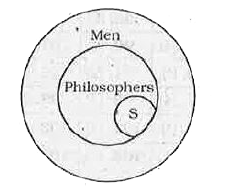In the following question, one statement is given , followed by two conclusion I and II. You have to consider the statement to be true even if it seems to be at variance from commonly known facts. You have to decide which of the given conclusions, if any, follow from the given statement.
Statement : All philosophers are men. Socrates was a philosopher.
Conclusion :
I. Socrates was a man.
II. Women cannot become philosophers.
Only I is valid
Only II is valid
Both are not valid
Both are valid
The correct Answer is:D

All philosphere without exception are men. So no woman can be philosopher.
Topper's Solved these Questions
- BOOK - KIRAN PUBLICATIONCHAPTER - SYLLOGISM, STATEMENT AND CONCLUSIONSEXERCISE - TYPE II193videos
SYLLOGISM, STATEMENT AND CONCLUSIONS
- BOOK - KIRAN PUBLICATIONCHAPTER - SERIESEXERCISE - TYPE-VI90videos
SERIES
- BOOK - KIRAN PUBLICATIONCHAPTER - SYMBOLS & NOTATIONSEXERCISE - TYPE-III38videos
SYMBOLS & NOTATIONS
Similar Questions
In the question, two statements are given, followed by two conclusions, I and II. You have to consider the statements to be true even if it seems to be at variance from commonly known facts. You have to decide which of the given conclusions, if any, follow(s) from the given statements.
Statement I: No ties are bows.
Statement 2: All bows are silk.
Conclusion I: some ties are silk.
conclusion II: Some silk are bows.View SolutionIn the question, two statements are given, followed by two conclusions I and II. You have to consider the statements to be true even if it seems to be at variance from commonly known facts. You have to decide which of the given conclusion, if any, follow(s) from the given statements.
Statement 1: No ties are bows. Statement 2: All bows are silk. Conclusion I: Some ties are silk. Conclusion II: Some silk are bows.View Solution
Knowledge Check
- Question 1 - Select One
In the following question, two statements are given followed by two conclusions I and II. You have to consider the statements to be true even if they seem to be at variance from commonly known facts. You have to decide which of the given conclusions, if any, follows from the given statements.
Statements :
A graduate is a man.
This thief is a graduate.
Conclusions :
I. This thief is a man.
II. Some men are thieves.AConclusion I followsBConclusion II followsCNeither I nor II followsDBoth I and II follow - Question 2 - Select One
In the following question, two statements are given followed by two conclusions I and II. You have to consider the statements to be true even if they seem to be at variance from commonly known facts. You have to decide which of the given conclusions, if any, follows from the given statements.
Statements :
All men are prisoners.
No prisoners are educated.
Conclusions :
I. All prisoners are educated.
II. No men are educated.AConclusion I followsBConclusion II followsCNeither I nor II followsDI and II both follow - Question 3 - Select One
In the following question, two statements are given followed by two conclusions I and II. You have to consider the statements to be true even if they seem to be at variance from commonly known facts. You have to decide which of the given conclusions, if any, follows from the given statements.
Statements :
Some bags are hot.
All hot things are cakes.
Conclusions :
I. All cakes are bags.
II. All bags are cakes.AConclusion I followsBConclusion II followsCNeither I nor II followsDBoth I and II follow
In the question two statements are given, followed by two conclusions, I and II. You have to consider the statements to be true even if it seems to be at variance from commonly known facts. You have to decide which of the given conclusions, if any, follows from the given statements.
Statement I: All sticks are canes
Statement II: Some wands are sticks
Conclusion I: Some canes are wands
Conclusion II: No wands are canesView SolutionIn each of the following questions, two statements are given followed by two/four conclusions I, II, III and IV. You have to consider the two statements to be true even if they seem to be at variance from commonly known facts. You have to decide which of the given conclusions, if any, follow from the given statements.
Statements :
(a) some players are men.
(b) Some men are singers.
Conclusions :
I. Some singers are men.
II. Some players are singers.View SolutionIn this question some statements are given. You have to consider the statements to be true even if they seem to be at variance from commonly known facts. You have to decide which of the given conclusion, if any, follows from the given statement.
All men are mortal.
Ramu is a man.View SolutionIn each of the following questions one/two statements are given followed by two conclusions I and II. You have to consider the two statements to be true even if they seem to be at variance from commonly known facts. You have to decide which of the given conclusions, if any, follow from the given statements.
Statements:
Dogs have four legs.
Tables have four legs. Conclusions
I. Tables are dogs.
II. Dogs are tables.View SolutionIn each of the following questions one/two statements are given followed by two conclusions I and II. You have to consider the two statements to be true even if they seem to be at variance from commonly known facts. You have to decide which of the given conclusions, if any, follow from the given statements.
Statements :
All animals are birds.
Some animals are human beings.
Conclusions :
I. Some human beings are birds.
II. Some birds are human beings.View Solution
